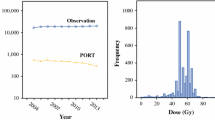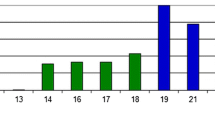Background and Purpose:
Up to now, evidence about survival of patients with non-small-cell lung cancer treated with radiation therapy alone is only available from clinical studies. The authors analyzed survival experience depending on several prognostic factors from a population-based cancer registry and compared this to survival data from the literature.
Patients and Methods:
Between April 1996 and September 1999, 1,696 patients with lung cancer were recruited by the Halle Lung Cancer (HALLUCA) Study. 1,183 patients were diagnosed as having non-small-cell lung cancer, and 188 in clinical stages I–IIIb (15.9%) were treated with radiation therapy alone.
Results:
The median survival time of all patients was 10.2 months, the 2-year overall survival rate amounted to 15.8%. Besides tumor stage, radiation dose was found to be a statistically significant prognostic factor for survival in univariate analysis. The median survival time was 4.2 months for 66 patients treated with < 50 Gy, 10.7 months for 80 patients treated with 50 to < 60 Gy, and 18.9 months for 42 patients treated with ≥ 60 Gy; the corresponding 2-year overall survival rates were 8.7%, 13.4%, und 35.2%. The significant influence of dose persisted even after adjustment for different confounders in a Cox regression model.
Conclusion:
Patients treated with 50 to < 60 Gy under a potentially curative therapeutic regimen had a significantly lower survival, compared to patients treated with ≥ 60 Gy. In terms of quality assurance, the large proportion of patients treated with radiation doses below the curative range of ≥ 60 Gy was unexpected.
Hintergrund und Ziel:
Bisher existieren Daten zum Überleben von Patienten mit nichtkleinzelligem Bronchialkarzinom nach alleiniger Strahlentherapie nur aus klinischen Studien. Deshalb wurde auf der Basis einer epidemiologischen Studie das Überleben in einem unselektierten Patientengut in Abhängigkeit von verschiedenen Prognosefaktoren analysiert und mit den Überlebensdaten aus der Literatur verglichen.
Patienten und Methodik:
Zwischen April 1996 und September 1999 wurden im Zuge der Halle’schen Lungenkrebsstudie (HALLUCA-Studie), einer multizentrischen Feldstudie zur Versorgungsqualität von Patienten mit Bronchialkarzinom in den Regierungsbezirken Halle und Dessau, aus einer Population von ca. 1,5 Mio. Einwohnern insgesamt 1696 inzidente Fälle mit Bronchialkarzinom rekrutiert. Von 1183 Patienten mit nichtkleinzelligem Karzinom erhielten 188 (15,9%) in den klinischen Tumorstadien I–IIIb eine alleinige thorakale Bestrahlung als Primärtherapie.
Ergebnisse:
Die mediane Überlebenszeit aller Patienten betrug 10,2 Monate, die 2-Jahres-Überlebensrate 15,8%. In der univariaten Überlebenszeitanalyse war neben dem Tumorstadium (Tabelle 4, Abbildung 3) die applizierte Gesamtherddosis von prognostischer Relevanz. Nach Gesamtherddosen von < 50 Gy, 50 bis < 60 Gy und ≥ 60 Gy wurden mediane Überlebenszeiten von 4,2, 10,7 und 18,9 Monaten sowie 2-Jahres-Überlebensraten von 8,7%, 13,4% und 35,2% erzielt (Tabelle 3, Abbildung 2). In der multivariaten Analyse bestand der erhebliche Einfluss der Gesamtherddosis fort (Tabelle 7, Abbildung 5).
Schlussfolgerung:
Patienten, die unter potentiell kurativer Intention mit Herddosen von 50 bis < 60 Gy bestrahlt wurden, überlebten im Vergleich zu den mit ≥ 60 Gy bestrahlten Patienten signifikant schlechter. Unter dem Aspekt der Qualitätssicherung war der Anteil an Patienten, die unter kurativer Zielsetzung mit Gesamtherddosen < 60 Gy bestrahlt wurden, unerwartet hoch.
Similar content being viewed by others
Author information
Authors and Affiliations
Consortia
Corresponding author
Additional information
* HALLUCA Study (Halle Lung Cancer Study, supported by the German Ministry of Health 1995–2001, FKZ FB 2—43332—70/8). Group: Heinz Neef, Cancer Center, Martin Luther University of Halle-Wittenberg; Johannes Haerting, Institute of Medical Epidemiology, Biostatistics and Informatics, Martin Luther University of Halle-Wittenberg; Wolfgang Schütte, City Hospital Martha Maria, Halle-Dölau; Jürgen Dunst, Department of Radiotherapy, Martin Luther University of Halle-Wittenberg; Wolfram Rosendahl, Division of Medical Psychology, Martin Luther University of Halle-Wittenberg; Peter Schmidt, Clinical Cancer Registry, Martin Luther University of Halle-Wittenberg; Wolfgang Slesina, Department of Medical Sociology, Martin Luther University of Halle-Wittenberg; Mathias Lange, social worker, Martin Luther University of Halle-Wittenberg.
Rights and permissions
About this article
Cite this article
Bollmann, A., Blankenburg, T., Haerting, J. et al. Survival of Patients in Clinical Stages I–IIIb of Non-Small-Cell Lung Cancer Treated with Radiation Therapy Alone. Strahlenther Onkol 180, 488–496 (2004). https://doi.org/10.1007/s00066-004-1184-7
Received:
Accepted:
Issue Date:
DOI: https://doi.org/10.1007/s00066-004-1184-7




